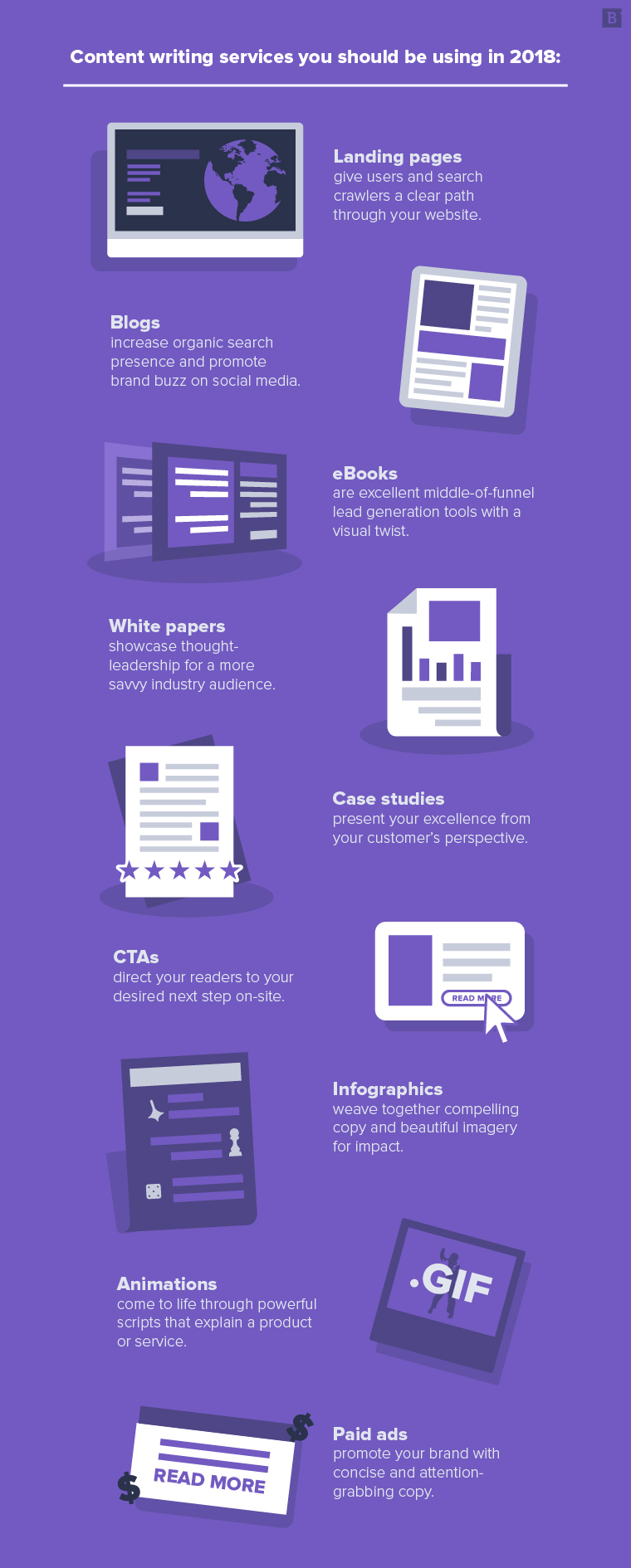Editor’s note: Updated June 2019.
So you’ve got a website but no idea what to put on it.
You’ve got several social media feeds but don’t know what to post.
Someone told you that you need “SEO,” but you couldn’t begin to plan out a content marketing strategy without double-checking what that acronym stands for.
OK, we may be laying it on a bit thick here.
But really, if your boss walked up to you right now and said, “We need to ramp up our web content – where do we start?” would you be able to answer confidently? Could you answer at all? Well could ya, Christina, 39-year-old Marketing Manager from Delaware?
No, seriously. That’s a buyer persona of ours, and it would most likely be her job to ideate a strategic marketing campaign, map out all creative assets and execute on all content, either using in-house staff or an agency vendor.
There are so many website content writing services
How many do you need?
We’ve got a helpful eBook on all the options available to you.

Long story short, the language that search engines use to crawl, understand and index your web pages is a combination of on-page copy and structured data.
While implementing data markup on your site will require some level of coding experience, CMS proficiency or plugin tool, your on-page text is easily manipulated by you yourself, or whomever you’ve employed to create your written content.
Without high-quality content that’s optimized for search, your web pages will live a lonely existence – no contact with the outside world beyond your own domain, with scant avenues for searchers to actually find and land on your content.
So, you’re going to need various types of content to satisfy human searchers as well as the search engines in which they query.
That’s how you compete online.
Just as you refine your core products, streamline your internal workflows and strive to generate as much profit as possible, you should pursue your digital dominance with the same level of determination and zeal.
Here’s how to accomplish that:
Landing pages
Your site architecture is essentially a hierarchy of interlocked landing pages, each having some sort of relation to the ones preceding and following it. Without them, search crawlers won’t be able to recognize a clear path through your website, making it highly unlikely that you’ll be able to rank for anything at all.
Optimized landing pages are absolutely essential to both paid and organic content marketing. Any baseline content writing service should be able to articulate this clearly. Vendors of a higher caliber may recommend a certain number of total landing pages and tie those to specific target keywords.
While too many landing pages may be just as bad as too few, your first objective when writing is to simply plan out a dedicated page for each of your services, in addition to other helpful resources like Contact Us, About Us and FAQ pages.
Insert internal links to your core landing pages in your blog posts to ensure the traffic you’re generating in search has somewhere to go once web visitors have finished reading – landing pages are a logical next step for those interested in potentially doing business with you.
Blogs
Speaking of blogs, you’re looking to produce buzz on social media and rank on page one of Google, right?
Blog content can help you achieve these tandem goals.
Think of blogs as the front door of your website, the entryway through which most visitors will first interact with your brand and engage with your content.
Consistently publishing blog posts, thought-leadership articles, opinion pieces and other forms of shareable, linkable content does several things:
- Keeps your domainwide authority and search presence fresh in the eyes of search engines.
- Provides your target audience and existing customers valuable resources to use and reuse over time.
- Allows your company to rank for competitive keywords.
- Draws steady flows of intent-driven traffic to your site, which can then be nurtured toward sales-focused landing pages.
- Fuels nondomain content marketing objectives like email and social media campaigns, webinar presentations and podcasting opportunities.
Your copywriters should be able to operate along the full spectrum of blog content needs and lengths, from 300-word roundups to 3,000-word epics.
eBooks
Quickly becoming the go-to format for gated content, eBooks add a visual flair to your content marketing.
Because eBooks live within the middle of the sales funnel, they make for excellent lead-generation tools by prompting prospects and potential customers to hand over their contact information to gain access to the full, downloadable versions which they can then circulate at will.
The key to a good eBook is to understand that text and design should complement one another, meaning there shouldn’t be too much copy on any given page lest you subvert how impactful the illustrations can be.
Which topics work best for eBooks?
The ones you can email to prospects. So, think large, relevant pain points your industry faces. Ones that are so pervasive that an email subscriber couldn’t resist reading the title and clicking on it.

White papers
Similar to eBooks, white papers play a pivotal role in lead gen. However, they differ in their format.
White papers are intended to be deep-dives into a research-heavy topic and may or may not include additional branding, formatting or illustration. They’re basically long-form blog posts for a more savvy industry audience.
Do you have compelling, proprietary data you’d like to share? Great ideas from your execs that the rest of the industry should hear? An insightful opinion on a prominent new technology soon to reshape the marketplace?
Funnel those thoughts into a white paper, gate it and make it easily accessible throughout your website, email campaigns and social media channels.
Case studies
Sometimes it’s best to let others sing your praises.
That’s what a great case study or customer testimonial can do for your brand.
Using more of a first-person, storytelling voice, a case study intertwines your company’s success with a customer’s quotes. This gives you a strong asset to show prospects and their respective stakeholders as they move further down the funnel.
Better yet, a case study that includes key data points and selective formatting can bring to life otherwise innocuous information.
Use your case studies to present your excellence without coming across as opportunistic or salesy.
CTAs
Content creation is only measurable if you’ve benchmarked it against a valuable conversion metric.
More often than not, your conversion goal for your content is the click of a call-to-action button, which likely leads to a form fill of some sort.
CTA writing is a specialization of its own, requiring strengths akin to traditional ad copywriting and leveraging the brevity of character restrictions.
Embedding a clickable CTA that utilizes action-oriented verbiage, dynamic colors and clear directives gives readers a next step to take on the page, whether it be a blog post, an eBook, web copy or what have you.
Use as few words as possible (no more than 4 for simple CTAs), and use them as often as possible.
Infographics
Though primarily a graphical asset, an infographic still relies on a wireframe of copy to convey meaning and context.
With that in mind, your words should be pulling double duty: getting your point across with data, concise language and metaphors, while also setting the stage for custom illustrations to accompany the text. The infographic is the perfect format to experiment with new styles and visions for engaging content. Dense subject matter can easily be distilled in an infographic, as can high-level information – it’s completely versatile and transferable to any type of industry or customer.
Already have a listicle? You can easily turn it into an infographic, letting the design and subheads speak for themselves.
Want a more dynamic email newsletter? Use infographics in addition to blog posts or other text-heavy content.
Because they’re so versatile, post your infographics within your blogs, on landing pages, on your social feeds and even at trade shows via a printable version.
Animations
Video scripts count as web content writing, too!
Scripts for animations, specifically, are used for narration voiceovers and subtitles, which means the written word should be treated more as the spoken word.
The use of flow, rhythm and cadence are more distinct features when writing for video as opposed to writing for, say, a blog. And because animations condense complex subjects into presentable ideas, you can use them to explain your products and services in short 2-minute videos.
Paid ads
If you’re hiring professional writers to articulate the core tenets of your content strategy, they should be capable of shifting from an inbound marketing to an outbound marketing mindset.
Paid ads differ from traditional content writing services because they are deployed in a disruptive way. These ads are effective only for the duration of time they are paid for – aka, they are not evergreen like many inbound assets.
Ads need to be hard-hitting and concise, getting to the point very quickly and in few words. And they can be worthwhile adjuncts to your organic efforts, broadening your brand reach and enabling you to own keywords over your competitors.
Think of paid ads not just as a recurring monthly investment but as a tool for solidifying your total online presence. Because search engine results pages (SERPs) often display three or more ads at both the top and bottom – sandwiching organic listings – you can gain valuable digital real estate with paid advertising.
But don’t stop there – promote and distribute via email and social
High-quality, relevant content is the crux of any successful content marketing strategy, but it still isn’t enough to elevate your brand and produce tangible ROI. You need strong promotion and distribution as well.
You paid for custom writing services, so customize your email and social media marketing strategies to get the most bang for your buck. To get started, you can:
- Share your content on each of your social channels depending on where your target audience interfaces with your brand online.
- Send out a newsletter via email so that you’re actually adding value to inbox-overloaded prospects.
- Use social platforms to converse with industry influencers and those with large social followings – you might get a backlink or a guest-posting opportunity out of it.
- Nurture leads with various forms of content tailored toward their stage in the sales funnel. You can easily set up an automated email campaign through MailChimp, Campaign Monitor or Hubspot.
If you need more tips on SEO, content writing and marketing in general, you know where to find us.





